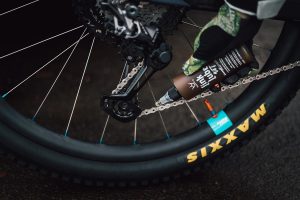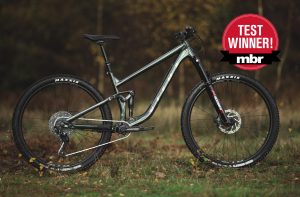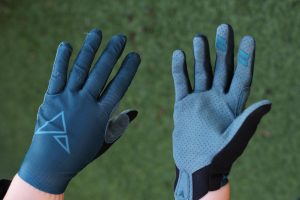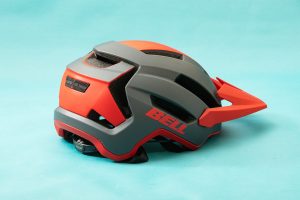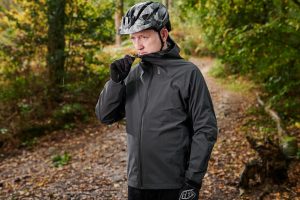We cut through they hype and recommend the very best enduro mountain bikes on the market; bikes that blend the downhill capability of a DH bike with the uphill prowess of a trail bike.
To be competitive, the best enduro mountain bikes need to strike the perfect balance between speed and efficiency on flatter trails, yet still be able to blast descents that wouldn’t look out of place on the World Cup DH circuit.
Even if you’re not competing, because mechanical support at races is minimised, the best mountain bike rigs destined for enduro race tape need to be ultra-reliable too. Look for travel between 160mm and 180mm combined with either 29in wheels front and rear, or mullet set-ups (29in front, 27.5in rear). Big rotors are a must (200mm) and reinforced tyres with a soft compound up front. Chain guides get fitted for extra security and you may even find a few coil shocks on some models.

Trek Slash test winner
Trek Slash 9.8
Actual one bike quiver
Wheel size: 29in | Frame sizes: S, M, M/L, L, XL | Weight: 15.02kg (33.11lb) | Suspension travel: 170mm f/160mm r | Rating: 10/10
Pros: Fast, fun and efficient. Tight, reactive ride. Progressive geometry. Versatile, composed. A do-it-all bike
Cons: XL would benefit from a steeper seat angle
For an enduro bike with progressive geometry, the Trek Slash 9.8 XT is incredibly versatile. Get on the gas and it responds with a sense of urgency that’s usually reserved for shorter travel bikes. Land deep of a drop, or jump, however, and the rear suspension graces you with a featherlight landing. Cool and composed in every situation the Trek Slash is not the outright plushed bike we’ve ever tested, but the suspension response is always proportional and measured, so you never feel under or over-biked. It’s what makes the Slash the ideal choice for anyone looking for that one do-it-all ride.
Read our full review of the Trek Slash 9.8 XT

Vitus Sommet 297 AMP
Vitus Sommet 297 AMP
Bike park mullet master
Wheel size: 29/27.5in | Frame sizes: S, M, L, XL | Weight: 15.37kg (33.9lb) | Suspension travel: 170mm f/170mm r | Rating: 9/10
Pros: Smooth, comfortable and fast, steeper seat angles for better climbing, superb sensitivity
Cons: Rear shock bobs under power
Even with a smaller rear wheel that normally ramps up trail feedback, the Vitus 297 AMP is every bit as smooth an operator as plenty of top-level 29in enduro bikes. In fact, with more rear travel in this mullet guise, it might be its best enduro bike from Vitus yet. The spectacular price doesn’t hurt either for a top quality frame with kit, handling and suspension that doesn’t skip a beat. The Vitus excels at pace with enough smoothness to devour downhills quickly while holding your hand down the steeps. Exactly what you want from a 170mm bike.
Read our full review of the Vitus Sommet 297 AMP

Nukeproof Giga
Devours the roughest tracks yet climbs with poise and efficiency
Wheel size: 27.5, 29in or mullet | Frame sizes: S, M, L, XL, XXL | Weight: 15.4kg | Suspension travel: 180mm f/170mm r | Rating: 10/10
Pros: All of the travel, none of the drawback.
Cons: Michelin tyres are temperature sensitive.
The Giga is testament to the adage that you can have your pudding and eat it. You can all of the all-ness all of the time. Loads of travel. Slack AF head angle. The biggest of wheel sizes. And the most remarkable thing? It rides just like a normal mountain bike when the gradient tips up. The Giga really is a race-worthy enduro bike that doesn’t feel like a chore to pedal around on your Sunday Social rides. Poppy and playful, the Giga is no passive plough.
Read our full review of the Nukeproof Giga 290 Carbon Factory

The Forbidden Dreadnought is a high-pivot idle bike with 170mm front travel and 29er wheels
Forbidden Dreadnought
High pivot, high performance
Wheel size: 29in | Frame sizes: S, M, L, XL | Weight: 15.99kg (35.25lb)| Suspension travel: 170mm f/154mm r | Rating: 9/10
Pros: Unique ride quality. Great sizing with balanced weight distribution across all sizes. Buttery-smooth suspension. Steep seat angle.
Cons: Needs a high-rise bar. End-stroke progression makes it harder to get full travel. Idler is noisy when it’s muddy. Longer chainstay and rearward axle path means you have to put more effort into lifting the front end.
In a world of copycat designs the Forbidden Dreadnought stands out as a genuine trailblazer. It’s not the first or the only idler design, but Forbidden’s approach with the size-specific chain stays lengths, 100% rearward axle path and associated chainstay growth at sag gives the Dreadnought a very distinct ride quality. It’s bigger than the static geometry suggests and if you like going fast in rough terrain, there’s probably no better 150mm travel bike – hey, if Connor Fearon can qualify at a World Cup DH on one, what’s stopping you?
Read our full review of the Forbidden Dreadnought

Whyte G-180 MX
Whyte G-180
Pedigree big hitter that’s designed and developed in the UK
Wheel size: 29in or mullet | Frame sizes: M, L, XL | Weight: 15.53kg | Suspension travel: F 180mm R 167mm | Rating: 9/10
Pros: Calm and composed.
Cons: Only three frame sizes in 29in.
Whyte has made in its suspension kinematics and geometry. Sure, you might expect a carbon frame at this price, but at 15.53kg (34.24lb) the alloy G-180 is still lighter than the full-carbon Nukeproof Giga and possibly more durable too. And while both bikes are level-pegging on the descents, Whyte loses out to Nukeproof on the ascents – its slacker seat angle and shorter stays making the G-180 a less comfortable place to be on long, arduous climbs. New for 2022, Whyte has introduced a mullet wheel version of the G-180, labelled ‘MX’.
Read our full test review of the Whyte G-180 Works 29er V1

Specialized Enduro Comp
Specialized Enduro
Simply amazing (shame about the price tag)
Wheel size: 29in | Frame sizes: S2, S3, S4, S5 | Weight: 14.59kg | Suspension travel: F 170mm R 170mm | Rating: 8/10
Pros: Fast in every situation.
Cons: Inconsistent XTR brakes. Price doesn’t add up with the S-Works version. Limited seat tube insertion depth.
It took time to get to grips with the latest Enduro 29. Initially we couldn’t get centred on the bike, and no amount of suspension tweaking seemed to improve matters. Once we fitted a shorter stem and flipped the geometry to the high setting though, we instantly hit it off. This bike is rapid, and the rougher the trail, the better it is. It rides light too, but most impressive is that this 170mm beast climbs more efficiently than many trail bikes with considerably less travel. Yes, the XTR brakes can’t be trusted, and the price is too high, particularly the S-Works model, but there’s no disputing the ride quality of the Enduro 29. It’s simply amazing.
Read our full test review of the Specialized Enduro S-Works 29

Yeti SB150
Everyone that’s ridden it simply loves it
Wheel size: 29in | Frame sizes: S, M, L, XL | Weight: 13.96kg | Suspension travel: F 170mm R 150mm | Rating: 10/10
Pros: An early incarnation of an enduro race winning machine
Cons: Showing its age a bit in terms of geometry
Yeti’s bikes have always looked amazing but the new SB150 is different animal. With 150mm travel on the rear, combined with a 170mm fork and a slack 64.3º head angle, this 29er enduro bike is an absolute weapon on the descents, yet you can still beast everyone on the climbs. The suspension is superbly balanced and the sizing is on point. Yes, Yeti has dumbed down some aspects of the built-kit from what the race team use, but that doesn’t stop the SB150 from being a truly impressive bike.
Read our full test review of the Yeti SB150 T-Series X01
Vitus Sommet
Race-ready 29er enduro bike that blows the doors off everything else at this price point
Wheel size: 29in | Frame sizes: S, M, L, XL | Weight: 15.75kg | Suspension travel: 170mm f/160mm r | Rating: 9/10
Pros: Neutral handling, killer build.
Cons: No low-speed adjuster on rear shock.
In the same vein as the Trek Slash or Yeti SB150, the Vitus Sommet CRS is a 29er enduro bike that is designed for big days in the saddle, not just sitting on your ass on a ski lift. And by simply swapping the sticky Maxxis MaxxGrip front tyre for a faster rolling MaxxTerra, it can easily serve double duty as a fast, efficient big-hitting trail bike. The fact that the complete bike costs less than the Yeti or Trek frame and weighs under 16kg, goes to show that you don’t need to sell your car to have a really nice bike.
Read our full review of the Vitus Sommet CRS

Specialized S-Works Turbo Kenevo SL
Specialized Turbo Kenevo SL
All the agility of an enduro bike with helping hand on the climbs
Frame: Carbon, 170mm travel | Motor: Specialized Turbo SL 2.2, 35Nm | Battery: Specialized 320Wh | Rating: N/A
Pros: Can descend with the best enduro bikes and leave them for dead on the climbs. Unobtrusive motor.
Cons: Battery can’t be removed easily. Seat tube lacks insertion depth. Price.
Yes, it’s an e-bike, but the Kenevo is the e-bike of the future, available now. Specialized’s highly regarded Enduro gets a lightweight motor and battery and the result is more than the sum of its (not inconsiderable) parts. Agile and powerful, every turn, every jump, every drift, every burst of acceleration – and they come thick and fast – felt natural and familiar on the Kenevo SL, yet also somehow more intense and satisfying than either a pure analogue bike or a full power e-bike could deliver. It inspired us to give more and it gave me more back in return. Every joule of energy we invested turned to profit – more speed, more control, more engagement, more fun. We really don’t want to be this gushing about a push bike that costs twelve and a half grand, but it’s everything we hoped for and more.
Read our full test review of the Specialized S-Works Turbo Kenevo SL

Sam Hill turned his hand to enduro, and his immense skill brought him numerous victories
What should I look for in the best enduro mountain bikes?
An enduro bike is basically a mountain bike with at least 150mm of suspension travel, but more commonly 160-180mm. They’re built for the rigours of racing full-bore downhill whilst being sufficiently efficient on climbs and contouring trails too. As racing is hard, days are long, trails are punishing and outside mechanical assistance is minimal, the bikes must be extremely durable and reliable too. First it needs to be lightning fast downhill. That’s because downhill sections make up the bulk of the timed runs in an enduro race. With some stages lasting upwards of ten minutes, and with limited practice time to learn the courses, the bike needs to be easy to ride and forgiving of bad line choices and cock-ups that are inevitable in the heat of the moment when fatigue sets in.
How important is climbing performance on an enduro bike?
Enduro isn’t simply about high-alpine marathon DH runs. The bikes also need to climb and pedal efficiently. With long liaison stages linking up the timed sections, the weight of the bike is also a factor as you don’t want to be carrying excess baggage on the climbs. Lighter bikes also needs less manhandling to guide them when you get tired, which becomes a massive bonus for those long days in the saddle. In a nutshell, a good enduro bike needs to be every bit as capable as a downhill bike, but as agile and efficient as a typical trail bike. That’s a pretty tall order, but the best modern enduro bikes fulfil that brief.
What sort of geometry does an enduro bike have?
The bottom bracket heights of a lot of our bikes hover at around the 350mm mark. But this measurement can’t be taken at full value, as all of the bikes have different amounts of suspension travel. If the bikes are all set with the same amount of suspension sag, then the bike with the shorter travel will have a higher bottom bracket. Another point to note about the BB height is that the axles of the 29 in wheels are higher than for the 650b wheels, so there is a greater BB drop, giving added stability. Head angles can be as slack as 62º, but most are in the 63-64º range. Manufacturers often add some kind of geometry adjustment, too, so riders can choose to prioritise certain handling characteristics. For more on this topic, read our deep dive into mountain bike geometry.
Does an enduro race bike make a good enduro bike for non-racers?
It’s amazing how enduro bikes have evolved in such a short space of time; the best new designs are now essentially lightweight mini-downhill bikes and, it seems, every man and his dog is now an enduro racer (mbr staff included). Cut through the marketing spiel, however, and one thing is crystal clear: longer-travel bikes are better than ever before, and we have enduro to thank for it. The reason is simple; racing breeds development. The latest enduro bike may not look dissimilar to the all-mountain bikes of yesteryear, but in fact they are very different animals. Due to the nature of the racing, this new breed is more DH focused, with slacker angles and better high-speed handling. In fact, the geometry isn’t too far off what you’d see if you strolled the pits at a World Cup DH race. But improvements to climbing performance and adjustable geometry means they make great bikes for riders who are not interested in racing – just hitting their local descents or riding a bike park. These are versatile rigs, begged to be ridden hard.








